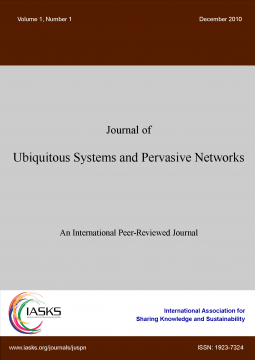volume-09-Issue 1 (2017)
Latest Articles
Improved SingleTapBraille: Developing a single tap text entry method based on Grade 1 and 2 braille encoding
JUSPN, volume-09, Issue 1 (2017) , PP 23 - 31
Published: 09 May 2017
DOI: 10.5383/JUSPN.09.01.003
by Mrim Alnfiaia, Srinivas Sampalli from Faculty of Computer Science, Dalhousie University, Halifax, B3H 1W5, Canada
Abstract: Touchscreen technology has brought about significant improvements for both normal sighted and visually impaired people. Visually impaired people tend to use touchscreen devices because these devices support a screen reader function, providing a cheaper, smaller alternative to screen reader machines. However, most of the available touchscreen keyboards are still largely inaccessible to blind and visually impaired people because they require the user to find an object location on a touchscreen in order to interact with an application. In this paper, we describe SingleTapBraille, a novel nonvisual text input approach for touchscreen devices. With SingleTapBraille, a user enters characters including text, numbers, and punctuations by tapping anywhere on the screen with one finger or a thumb several times based on braille patterns. This paper presents our initial keyboard design to enter Grade 1 and our explorative evaluation of SingleTapBraille conducted with braille instructors and visually impaired users. It also presents the implementation of Grade 2 and an initial evaluation of the improved SingleTapBraille keyboard with a blind user. read more... read less...
Keywords: Accessibility, text entry, blindness, braille, touchscreens, mobile devices, single-touch interaction techniques, speech output
The AREA Framework for Location-Based Smart Mobile Augmented Reality Applications
JUSPN, volume-09, Issue 1 (2017) , PP 13 - 21
Published: 17 Jul 2017
DOI: 10.5383/JUSPN.09.01.002
by Rüdiger Pryss, Philip Geiger, Marc Schickler, Johannes Schobel, Manfred Reichert from Institute of Databases and Information Systems, Ulm University, Ulm, Germany, 89081
Abstract: During the last years, the computational capabilities of smart mobile devices have been continuously improved by hardware vendors, raising new opportunities for mobile application engineers. Mobile augmented reality can be considered as one demanding scenario demonstrating that smart mobile applications are becoming more and more mature. In the AREA (Augmented Reality Engine Application) project, we developed a powerful kernel that enables location-based, mobile augmented reality applications. On top of this kernel, mobile application developers can realize sophisticated individual applications. The AREA kernel, in turn, allows for both robustness and high performance. In addition, it provides a flexible architecture that fosters the development of individual location-based mobile augmented reality applications. As a particular feature, the kernel allows for the handling of points of interests (POI) clusters. Altogether, advanced concepts are required to realize a location-based mobile augmented reality kernel that are presented in this paper. Furthermore, results of an experiment are presented in which the AREA kernel was compared to other location-based mobile augmented reality applications. To demonstrate the applicability of the kernel, we apply it in the context of various mobile applications. As a lesson learned, sophisticated mobile augmented reality applications can be efficiently run on present mobile operating systems and be effectively realized by engineers using the AREA framework. We consider mobile augmented reality as a killer application for mobile computational capabilities as well as the proper support of mobile users in everyday life. read more... read less...
Keywords: Mobile Augmented Reality, Location-based Algorithms, Mobile Application Engineering, Augmented Reality
Safety-Critical Mobile Systems – The RESCUER Interaction Evaluation Approach
JUSPN, volume-09, Issue 1 (2017) , PP 01 - 10
Published: 09 May 2017
DOI: 10.5383/JUSPN.09.01.001
by Konstantin Holl, Claudia Nass, Vaninha Vieira, Karina Villela from Fraunhofer IESE, Kaiserslautern, Germany, 67663 Fraunhofer Project Center, Federal University of Bahia, Salvador, Brazil, 40110-170
Abstract: The infrastructure organization of large-scale events involves high safety requirements for the visitors and is a central issue for the officials in charge. To assist in dealing with this, we developed the RESCUER Mobile Crowdsourcing App, which runs on smartphones and allows the crowd to report an emergency, thereby improving the process for rescuing humans in an emergency. For the evaluation of the app, we faced the problem that people participating in a large event, such as a soccer match, are not willing to spend time on completing a long survey or interview. Also, people experiencing an emergency situation may have their cognitive capabilities affected by emotional burden, so a mobile app should be easy and intuitive to interact with. Hence, the goal of this contribution was to select and perform an on-site mobile evaluation approach that allows us to evaluate the user interaction. Two main evaluations were performed using two different versions of our application. The first evaluation took place during the FIFA World Cup 2014 and tested the app’s usability with 112 users in Brazil and in Germany. As a result of this evaluation, we found severe usability issues and gained concrete insights into how to solve them. The second, follow-up evaluation, using an improved version of our app, was performed during emergency exercises in Brazil, with 31 experts in emergency management. For our evaluation approach, the results indicated that on-site mobile evaluation is an appropriate method for improving the usability and interaction of safety-critical software systems. read more... read less...
Keywords: Mobile app, Emergency management, Evaluation, Usability

